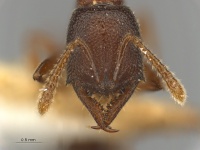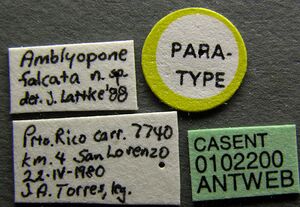Fulakora falcata
| Fulakora falcata | |
|---|---|

| |
| Scientific classification | |
| Kingdom: | Animalia |
| Phylum: | Arthropoda |
| Class: | Insecta |
| Order: | Hymenoptera |
| Family: | Formicidae |
| Subfamily: | Amblyoponinae |
| Tribe: | Amblyoponini |
| Genus: | Fulakora |
| Species: | F. falcata |
| Binomial name | |
| Fulakora falcata (Lattke, 1991) | |
This uncommon species is found in the Greater Antilles (Puerto Rico and Dominican Republic) and the Lesser Antilles (Saint Thomas) where it occurs in leaf litter. The holotype series was taken from leaf litter in the Carite subtropical wet forest.
Identification
Lattke 1991: Fulakora falcata may be confused with the Cuban Fulakora bierigi Santschi, a species known only from the holotype. Fulakora bierigi, however, lacks the yellow spot on gastric sternite II of F. falcata and has 12-merous antennae rather than 11, and sparser punctulae on the body. The combination of 11 antennal segments and the distinctive spot on the gastric ventrum sets F. falcata apart from all other known species of the genus. Reduced antennal segmentation is known in Fulakora degenerata Borgmeier (6 or 7) from SE Brazil and SE Peru, and Fulakora gnoma Taylor (10) from Guadalcanal Island. SEM examination of the unique gastric spot at 150 x failed to reveal openings or other sculpturing of taxonomic interest, only smooth integument.
Keys including this Species
- Key to Hispaniola Subfamilies
- Key to Stigmatomma species of the Americas
- Key to Stigmatomma with eleven-segmented antenna
Distribution
Latitudinal Distribution Pattern
Latitudinal Range: 18.326° to 18.02571°.
| North Temperate |
North Subtropical |
Tropical | South Subtropical |
South Temperate |
- Source: AntMaps
Distribution based on Regional Taxon Lists
Neotropical Region: Dominican Republic, Greater Antilles, Lesser Antilles, Puerto Rico (type locality).
Distribution based on AntMaps
Distribution based on AntWeb specimens
Check data from AntWeb
Countries Occupied
| Number of countries occupied by this species based on AntWiki Regional Taxon Lists. In general, fewer countries occupied indicates a narrower range, while more countries indicates a more widespread species. |

|
Estimated Abundance
| Relative abundance based on number of AntMaps records per species (this species within the purple bar). Fewer records (to the left) indicates a less abundant/encountered species while more records (to the right) indicates more abundant/encountered species. |

|
Biology
This species occurs in leaf litter.
Castes
Only the worker caste has been described. Queens have been collected in the Dominican Republic (G. Alpert, deposited in the MCZ) but are undescribed. Males are unknown.
Workers
Images from AntWeb
  
| |
| Worker. Specimen code casent0102200. Photographer April Nobile, uploaded by California Academy of Sciences. | Owned by NHMUK, London, UK. |
Images from AntWeb
   
| |
| Holotype of Fulakora falcata. Worker. Specimen code casent0172809. Photographer April Nobile, uploaded by California Academy of Sciences. | Owned by MCZ, Cambridge, MA, USA. |
Nomenclature
The following information is derived from Barry Bolton's Online Catalogue of the Ants of the World.
- falcata. Amblyopone falcata Lattke, 1991c: 1, fig. 1 (w.) PUERTO RICO.
- Type-material: holotype worker, 9 paratype workers.
- Type-locality: holotype Puerto Rico: Guayama, carr. 7740, km. 4 (8 km. N Guayama, 18°4’N, 66°07’W, 985 m.), San Lorenzo, 22.iv.1980, no. 33 (J.A. Torres); paratypes: 8 workers with same data, 1 worker Puerto Roci: Aguas Buenas Forest, Aguas Buenas Cave, 18°14’N, 66°07’W, 250 m., 7-17.v.1973 (S. Peck).
- Type-depositories: LACM (holotype); BMNH, LACM, MCZC, MIZA, MZSP (paratypes).
- Combination in Stigmatomma: Yoshimura & Fisher, 2012a: 19;
- combination in Fulakora: Ward & Fisher, 2016: 691.
- Status as species: Bolton, 1995b: 62; Lacau & Delabie, 2002: 40 (in key); Bharti & Rilta, 2015b: 509 (in key); Lubertazzi, 2019: 113.
- Distribution: Dominican Republic, Puerto Rico.
Unless otherwise noted the text for the remainder of this section is reported from the publication that includes the original description.
Description
Worker
Holotype (paratypes) dimensions: HL 1.12 (0.73-1.10), ML 0.98 (0.41-0.98), HW 1.00 (0.57-1.00), SL 0.63 (0.37-0.65), WL 1.32 (0.85-1.32) mm, CI 0.89 (0.75-0.91), MI 0.98 (0.72-0.98), SI 0.63 (0.65-0.66); n = 6.
Head in full face view with concave posterior margin, sides weakly convex and diverging anterad. Anterior clypeal margin convex, with 6-8 teeth: 2 median teeth may be separate or fused to variable degree, 2 intermediate teeth and 2 lateral triangular teeth. Gular teeth small and sharply pointed. Mandibles elongate with concave outer margins: apical tooth long and sharp, preapical tooth very small and subquadrate (sometimes slightly emarginate medially and in small specimens tubercle-like), followed by 5 double teeth fused basally, and a large and triangular innermost tooth. Mandibles in small specimens relatively broader and with more convex inner preapical border; double teeth tend to be more fused basad.
Frontal carinae contiguous, separated only by slight suture. Apex of antennal scape reaching back 2/3 of head and narrowest medially. Funiculus 10-merous, each segment constricted one from another and incrassate apicad, not forming distinct club. Funicular segments I-V, X longer than broad; VIIX long as broad. Anterior one-third to one-fourth of head with parallel longitudinal rugae that diverge slightly posterad, very weakly impressed median longitudinal sulcus reaches vertex or a little before it. Eyes absent. Dorsum of head densely unctatereticulate, each puncture with central piligerous tubercle. Punctures slightly less dense on lateral and ventral sides of head. Occiput shining and with sparse shallow punctures.
Mesosoma laterally with pronotum convex and separated by deep suture from straight and slightly descending mesonotum. Metanotum and dorsal propodeal face slightly convex, gently curving down to feebly convex declivitous face. Most of mesosoma smooth and shining with numerous piligerous punctures except for narrow median longitudinal band that extends caudad over mesosomal dorsum with fewer punctures, appearing smoother. Mesonotum transverse and dorsally narrowest part of mesosoma; metanotal suture sometimes impressed as fine shallow transverse sulcus. Propodeum with posterolateral striae, declivitous face with almost glabrous inferomedian area and with superolateral punctures and inferolateral transverse striae. Mesepisternum with horizontal rugulae. Sides of procoxa with oblique rugulae and dispersed punctures. Sides of metepisternum and propodeum with few punctures. Propodeal spiracle oval.
Petiole laterally with fairly straight anterior margin, meeting the weakly convex face at sharp angle. Gaster smooth and shining, with numerous piligerous punctures; acrotergite with very fine transverse striae; base of gastric segment II scrobiculate; postpetiolar sternite with larger punctures and appearing roughened. Gastric sternite II with boomerangshaped, beige to yellow patch, outlined in brown. Pygidium densely punctate, with some longitudinal rugae. Subpetiolar process is translucent rounded lobe anteriorly directed. Petiole and postpetiole dorsally broader than long. Tibiae and femora smooth and shining with abundant punctures. Empodia present, claws simple. Large pectinate spur on protibial apex, none on mesotibia and one long pectinate spur plus smaller, slender straight spur at metatibial apex.
Most of body covered with short and dilute appressed pubescence; antennae, tibia, and gastric apex with some decumbent hairs, erect hairs present on gastric apex. No pubescence on mes- and metepisterna. Color mostly ferruginous-yellow, legs and gaster slightly paler.
Type Material
Holotype worker and eight nidoparatypic workers: PUERTO RICO, Guayama, Carr. 7740, km 4 (8 km N Guayama, 18"04'N 66"07'W, 985 m), San Lorenzo, 22-IV-1980,j.A. Torres, col., no. 33. One paratype worker PUERTO RICO, Aguas Buenas 'Forest at Aguas Buenas Cave, 18°14'N 66"07'W, 250 m, 7-17 May 1973, S. Peck, leg. Holotype worker Los Angeles County Museum of Natural History. Paratypes Los Angeles County Museum of Natural History, Instituto de Zoologia Agricola, Museum of Comparative Zoology, The Natural History Museum and MZUSP.
Etymology
The species epithet falcata is derived from the Latin adjective falcatus and alludes to the sickle-shaped mandibles of the ant.
References
- Lattke, J. E. 1991d. Studies of neotropical Amblyopone Erichson (Hymenoptera: Formicidae). Contr. Sci. (Los Angel.) 428: 1-7 (page 1, fig. 1 worker described)
- Lubertazzi, D. 2019. The ants of Hispaniola. Bulletin of the Museum of Comparative Zoology, 162(2), 59-210 (doi:10.3099/mcz-43.1).
- Ward, P.S. & Fisher, B.L. 2016. Tales of dracula ants: the evolutionary history of the ant subfamily Amblyoponinae (Hymenoptera: Formicidae). Systematic Entomology, 41, 683–693 (doi:10.1111/syen.12186).
- Yoshimura, M. & Fisher, B.L. 2012. A revision of male ants of the Malagasy Amblyoponinae (Hymenoptera: Formicidae) with resurrections of the genera Stigmatomma and Xymmer. PLoS ONE 7(3):e33325 (doi:10.1371/journal.pone.0033325).
References based on Global Ant Biodiversity Informatics
- Lacau S., and J. H. C. Delabie. 2002. Description de trois nouvelles espèces d'Amblyopone avec quelques notes biogéographiques sur le genre au Brésil (Formicidae, Ponerinae). Bulletin de la Société Entomologique de France 107: 33-41.
- Scott-Santos, C.P., F.A. Esteves, C.R.F. Brandao. 2008. Catalogue of "Poneromorph" ant type specimens (Hymenoptera, Formicidae) deposited in the Museu de Zoologia da Universidade de Sao Paulo, Brazil. Papeis Avulsos de Zoologia 48(11):75-88.
- Torres, Juan A. and Roy R. Snelling. 1997. Biogeography of Puerto Rican ants: a non-equilibrium case?. Biodiversity and Conservation 6:1103-1121.

